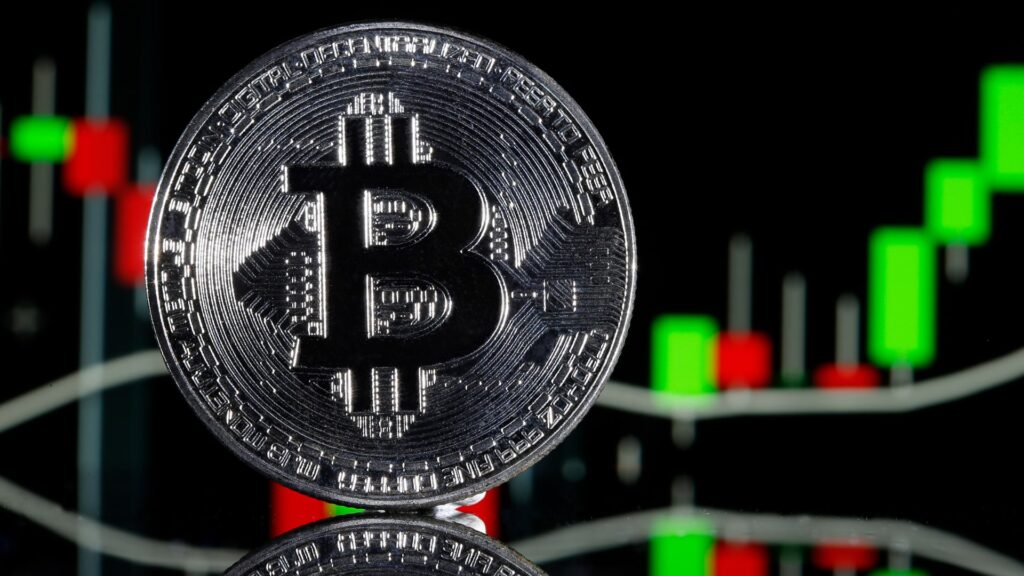Bitcoin’s price has been stuck in a narrow range since March 9, unable to break past the $84,000 resistance level. Data from Cointelegraph Markets Pro and Bitstamp shows BTC trading between $78,599 and $84,000, reflecting broader market uncertainty.
Factors Contributing to Bitcoin’s Stagnation
Economic and Political Uncertainty
Bitcoin’s lack of momentum is tied to macroeconomic factors, including concerns over inflation and geopolitical instability. Policies from the Trump administration, including proposed trade tariffs on Mexico and Canada, have rattled markets. Investors remain cautious about risk assets like Bitcoin, leading to weakening demand.
Weakening Demand and Neutral Funding Rates
According to Glassnode, Bitcoin’s post-election rally has lost steam, reflecting a hesitant market. Short-term holders’ cost basis exceeded that of longer-term holders in Q1, indicating reduced demand. As BTC dropped below $95,000, capital outflows accelerated, reinforcing a shift from post-all-time-high optimism to a more cautious outlook.
Glassnode reported: “This reversal indicates that macro uncertainty has spooked demand, reducing new inflows… and suggests that new buyers are now hesitant to absorb sell-side pressure.”
Perpetual futures funding rates, a measure of speculative interest, are hovering close to 0%, signaling increased indecisiveness among traders.
Key Resistance Levels
Bitcoin is struggling to reclaim key technical levels. On March 9, BTC fell below the 200-day simple moving average (SMA) at $83,736, which has acted as a resistance barrier since. Analysts suggest that a decisive move above this level and the 200-day EMA at $86,000 is necessary to confirm renewed bullish momentum.
Crypto analyst Daan Crypto Trades emphasized the importance of these indicators: “The 200-day SMA and EMA are crucial for determining the mid-to-long-term trend. Failure to reclaim these levels could lead to extended consolidation.”
For now, Bitcoin remains stuck in a tight range, awaiting the next major catalyst to determine its direction.
Bitcoin saw a sharp sell-off on March 12 following the latest U.S. inflation data. After reaching a three-day high of $84,437, BTC/USD quickly reversed course as bearish pressure emerged.
The U.S. Consumer Price Index (CPI) for January came in below expectations at 2.8%, signaling a slowdown in inflation. Core CPI, which excludes volatile food and energy prices, fell to 3.1%—also lower than expected.
“This marks the first decline in both Headline and Core CPI since July 2024. Inflation is cooling down in the US,” noted The Kobeissi Letter, a trading analysis firm.
Despite this seemingly positive data, Wall Street’s opening saw renewed selling pressure across the cryptocurrency market. Bitcoin fell to $82,400 before stabilizing around its daily opening price.
Technical Indicators and Market Trends
Popular crypto analyst Rekt Capital pointed out that Bitcoin has started to exit a previously filled CME Gap—an important price zone linked to Bitcoin futures trading on CME Group. “Any dips into the top of the CME Gap would constitute a post-breakout retest attempt to fully confirm the exit from this CME Gap. Initial signs of that retest occurring already,” he explained.
Other analysts focused on key technical indicators such as the 200-day Simple and Exponential Moving Averages (SMA/EMA), which serve as crucial support levels in bull markets.
“Bulls got work to do here to get back above the Daily 200MA/EMA. Last year we had the same thing and price chopped around these levels for 3+ months,” noted trader Daan Crypto Trades. Currently, these levels sit at $83,550 and $85,650, respectively.
Bitcoin ETF Outflows Indicate Institutional Caution
On the macroeconomic front, trading firm QCP Capital suggested that the CPI data could influence the Federal Reserve’s upcoming decision on interest rates.
“With inflation concerns lingering and macro risks mounting, the CPI print will be a key determinant of whether the disinflationary trend will hold, or volatility intensifies in the near term,” QCP stated in its latest market update.
Institutional investors are also showing signs of caution. Bitcoin exchange-traded funds (ETFs) experienced a significant net outflow of $153.87 million, largely driven by Grayscale’s Bitcoin Trust (GBTC). GBTC offloaded 641 BTC worth $56.45 million, bringing its total holdings down to 195,746 BTC, valued at approximately $17.24 billion.
“This signals growing caution among institutional investors,” QCP concluded.
Looking Ahead: Market Uncertainty Persists
With inflation concerns still present and institutional investors adopting a more cautious approach, Bitcoin’s short-term price action remains uncertain. However, key support levels around $82,000 appear to be holding for now.
As traders and investors navigate these developments, all eyes remain on the Federal Reserve’s upcoming policy decisions and how they might impact broader market sentiment.
Bitcoin has recently seen a notable pullback, dropping more than 14% over the past week to around $80,700. This downturn has raised concerns among investors about whether the bull market is coming to an end. However, several analysts suggest that this retracement is simply a normal correction within a broader uptrend.
Market Reaction and Key Factors Behind the Drop
The latest decline in Bitcoin’s price has coincided with growing uncertainty in global financial markets. A recent executive order, which was initially perceived as positive for cryptocurrency adoption, ended up disappointing investors. The order suggested using confiscated cryptocurrencies to create a Bitcoin reserve but did not include direct federal investment in Bitcoin. This led to a negative reaction in the market.
Some analysts see this drop as part of a larger macroeconomic correction, with global markets adjusting to changing fiscal policies, tariff uncertainties, and recession fears. The decline has broken key support levels across various cryptocurrencies, making future price movements difficult to predict. However, analysts remain focused on Bitcoin’s next critical level, estimated to be around $71,000 to $72,000.
Historical Perspective on Bitcoin Corrections
One prominent industry figure has pointed out that Bitcoin’s current price behavior is still in line with historical bull markets. A 36% correction from Bitcoin’s all-time high of $110,000 would place it around $70,000, which remains a normal level for a bull market retracement.
Corrections of this magnitude have occurred multiple times in previous cycles without signaling the end of a bull market. Given the scale of Bitcoin’s price appreciation over the past year, a temporary pullback is considered healthy rather than alarming.
The Role of Central Bank Policies
Another important factor influencing Bitcoin’s price is global monetary policy. Some expect central banks, including the Federal Reserve and others, to implement liquidity-boosting measures in response to economic conditions. Historically, when central banks have engaged in monetary easing, Bitcoin has benefitted significantly.
During a previous period of quantitative easing, Bitcoin’s price surged over 1,000%, demonstrating how monetary expansion can drive demand for digital assets. If a similar approach is taken by central banks in response to economic challenges, Bitcoin could see renewed upward momentum.
Market Outlook and Long-Term Predictions
Despite the current downturn, long-term price targets for Bitcoin remain optimistic. Analysts continue to project potential highs of $160,000 to $180,000 by the end of 2025. These forecasts are based on increasing institutional adoption, expanding Bitcoin ETF offerings, and growing retail interest.
Bitcoin’s price cycles have historically included significant corrections before reaching new all-time highs. The current pullback does not necessarily indicate a reversal of the overall bullish trend but rather a period of consolidation before further gains.
Conclusion
While Bitcoin’s recent decline to around $80,000 has caused concern, many experts view this as a routine correction within an ongoing bull market. Historical patterns, potential monetary policy shifts, and continued institutional interest suggest that Bitcoin’s long-term growth remains intact. Investors are advised to focus on the broader trend rather than short-term fluctuations.
Coinbase, a leading cryptocurrency exchange, has announced plans to offer 24/7 trading for Bitcoin (BTC) and Ether (ETH) futures to U.S. residents. This strategic move aims to expand the exchange’s derivatives offerings and position Coinbase competitively within the U.S. crypto market.
Addressing Market Inefficiencies
The current crypto derivatives market predominantly operates outside U.S. borders, compelling American traders to navigate fixed trading hours and contracts with set expirations. These constraints can lead to inefficiencies and limit market participation. By introducing around-the-clock trading and perpetual futures with extended expirations, Coinbase seeks to mitigate these challenges and provide U.S. traders with more flexibility.
Understanding Perpetual Futures
Futures contracts are derivatives that obligate the purchase or sale of an asset at a predetermined price and date. Perpetual futures, however, lack a specified expiration date, allowing traders to hold positions indefinitely. This feature offers continuous exposure to the underlying asset without the need to roll over contracts, making it a popular instrument among crypto traders.
Navigating Regulatory Landscapes
The regulatory environment surrounding crypto perpetual futures in the U.S. has been marked by uncertainty, leading many exchanges to restrict access for U.S. residents. Coinbase is proactively collaborating with the Commodity Futures Trading Commission (CFTC) to ensure its new offerings comply with regulatory standards. The CFTC oversees commodity futures trading to maintain market integrity and protect participants.
Competitive Landscape
Coinbase’s entry into the 24/7 futures trading arena positions it against established entities such as the CME Group and emerging competitors like Robinhood.
- CME Group: As a prominent U.S. derivatives exchange, CME Group reported $6.1 billion in revenue in 2024. In the last quarter of 2024, it recorded an average daily trading volume of $10 billion for crypto derivatives. However, CME’s crypto derivatives are available for trading only six days a week, presenting a potential advantage for Coinbase’s continuous trading model.
- Robinhood: In January, Robinhood announced plans to offer Bitcoin and Ether futures, signaling its intent to diversify its crypto offerings. Coinbase’s established presence and comprehensive services may provide a competitive edge in attracting a broader user base.
Market Potential
The crypto derivatives market has experienced substantial growth, reaching a monthly trading volume of $1.3 trillion in September 2023. This figure surpasses the spot crypto market, indicating a robust demand for derivatives products. By introducing 24/7 futures trading, Coinbase aims to capture a significant share of this burgeoning market and cater to the evolving needs of U.S. traders.
Conclusion
Coinbase’s initiative to launch 24/7 Bitcoin and Ether futures trading represents a pivotal development in the U.S. cryptocurrency landscape. By addressing existing market inefficiencies and navigating regulatory complexities, Coinbase is poised to enhance its service offerings and strengthen its position in the competitive crypto derivatives market.
The cryptocurrency industry is advocating for comprehensive regulatory clarity, emphasizing that clear policies are more crucial than the establishment of a national Bitcoin reserve. Industry executives express that while the creation of a U.S. strategic Bitcoin reserve aligns with President Donald Trump’s pro-crypto stance, it falls short of addressing the pressing need for detailed guidance on securities regulation and taxation.
The Executive Order and Industry Response
On March 6, President Trump signed an executive order to establish a U.S. strategic Bitcoin reserve, fulfilling a campaign promise to bolster the nation’s crypto holdings. This reserve, along with a separate digital asset stockpile for altcoins, is intended to position the United States as a leader in the cryptocurrency space. However, industry leaders remain underwhelmed, citing a lack of immediate action and specificity in the order.
Max Giammario, CEO of Web3 artificial intelligence startup Kindred, commented on the situation, stating, “Markets expect a roadmap for innovation and clear guidelines on stablecoins, institutional adoption, and taxation. Instead, the vague rhetoric and lack of immediate action only deepened uncertainty.”
Market Reaction and Current Challenges
Following the executive order, the cryptocurrency market experienced notable fluctuations. Bitcoin’s value declined by approximately 13% since March 6, reflecting traders’ disappointment and broader macroeconomic uncertainties. Altcoins mirrored this trend, contributing to a loss of over $400 million in total crypto market capitalization.
Alvin Kan, Chief Operating Officer of Bitget Wallet, highlighted the potential consequences of continued ambiguity: “If Trump’s administration provides clearer regulations on stablecoins, ETFs, and institutional adoption, altcoins could regain momentum. Otherwise, Bitcoin dominance may continue, as it remains the primary macro asset.”
The Call for Regulatory Framework
The consensus among industry executives is that establishing a clear regulatory framework is paramount for the growth and stability of the cryptocurrency sector. Specific areas requiring attention include:
- Stablecoin Regulation: Defining the legal status and operational guidelines for stablecoins to ensure transparency and consumer protection.
- Institutional Adoption: Creating policies that encourage institutional participation in the crypto market, thereby enhancing liquidity and market maturity.
- Taxation Policies: Clarifying tax obligations related to cryptocurrency transactions to eliminate uncertainties for investors and businesses.
Theodore Agranat, Director of Web3 at Gunzilla Games, expressed optimism about future developments: “Given the people in all the crucial positions, we should expect to see a stream of ongoing and positive initiatives and news for crypto in general and especially crypto projects in the US.”
Conclusion
While the establishment of a national Bitcoin reserve signifies a positive shift in governmental recognition of cryptocurrencies, the industry’s growth hinges on comprehensive and clear regulatory policies. Addressing these foundational issues is essential for fostering innovation, protecting consumers, and solidifying the United States’ position as a leader in the global cryptocurrency landscape.
Bitcoin is teetering on the edge of a significant support level, with analysts warning of increased volatility if it closes the week below $82,000. This precarious position comes in the wake of investor dissatisfaction with the U.S. government’s recent approach to establishing a Strategic Bitcoin Reserve.
On March 7, President Donald Trump signed an executive order to create a Bitcoin reserve. However, instead of actively purchasing Bitcoin from the market, the plan involves utilizing cryptocurrencies forfeited in criminal cases. This strategy has tempered investor expectations, as many had anticipated direct federal investment in Bitcoin, which could have bolstered market confidence.
Analysts commented on the situation, stating that the reliance on existing holdings without additional investments has led to a near-term negative market reaction and a decline in Bitcoin’s price. They emphasized the importance of Bitcoin maintaining its position above the $82,000 support level to prevent further downturns.
Broader Economic Factors Influencing Bitcoin’s Performance
Beyond the specifics of the U.S. Bitcoin Reserve, Bitcoin’s price is also being influenced by broader macroeconomic factors. Analysts highlighted that upcoming U.S. economic indicators, such as the Consumer Price Index and job openings report, will play a crucial role in determining Bitcoin’s short-term movements. These reports are expected to shed light on inflation trends and labor market strength, potentially influencing future interest rate decisions.
Potential Consequences of Breaching the $82,000 Support Level
Should Bitcoin fail to maintain the $82,000 support, the market could experience heightened volatility. Data indicates that a drop below this level might trigger over $1.13 billion in cumulative leveraged long liquidations across various exchanges. Such liquidations could exacerbate the downward pressure on Bitcoin’s price, leading to a more pronounced market correction.
Technical Indicators Suggest Possible Rebound
Despite the current challenges, some technical indicators offer a glimmer of hope for Bitcoin. The Relative Strength Index (RSI), which measures whether an asset is oversold or overbought, has recently dipped to 28 on the daily chart. Historically, when Bitcoin’s RSI reaches this level, it often signals that the asset is oversold, potentially indicating an impending price rebound. Crypto analysts noted that in previous instances during this cycle, Bitcoin’s price either bottomed out or was within a 2% to 8% range of its lowest point when the RSI hit 28.
Conclusion
Bitcoin’s immediate future hinges on its ability to uphold the $82,000 support level amidst investor disappointment over the U.S. government’s conservative approach to its Strategic Bitcoin Reserve. Coupled with broader economic indicators set to be released, the cryptocurrency market is poised for potential volatility. Investors are advised to monitor these developments closely, as they could significantly influence Bitcoin’s trajectory in the coming weeks.
Since the onset of 2025, Solana (SOL) has experienced a nearly 29% decline in its value, despite efforts to bolster its liquidity and its inclusion in the U.S. Digital Asset Stockpile. This downturn highlights the challenges faced by altcoins in maintaining investor confidence amidst broader market fluctuations.
U.S. Digital Asset Stockpile: A Double-Edged Sword?
In a move to strengthen the nation’s position in the digital asset space, President Donald Trump announced the inclusion of select cryptocurrencies, including Solana, Cardano (ADA), and XRP, into the U.S. Digital Asset Stockpile. While this inclusion was expected to enhance Solana’s market appeal, the anticipated positive impact has yet to materialize. Some analysts believe that the government’s passive approach—relying on seized assets rather than active market participation—has led to subdued investor enthusiasm.
Liquidity Surge Fails to Revitalize Solana’s Price
In an attempt to invigorate the cryptocurrency market, over $9.5 billion worth of newly minted USD Coin (USDC) stablecoins have been introduced since January 1, 2025. However, this substantial liquidity injection has not translated into a price recovery for Solana. Data suggests that a significant portion of this new liquidity may have been diverted into memecoins, thereby limiting its positive effect on SOL’s valuation.
Impact of Memecoin Mania on Solana
The launch of the Official Trump (TRUMP) token has had unintended consequences for Solana. Since its introduction, SOL’s price has plummeted by 49%, dropping from $261 on January 18 to $133 by March 9. Observers noted that the fervor surrounding the TRUMP token led investors to liquidate other crypto assets, including Solana, to capitalize on the new opportunity. This shift in investment focus has contributed to the downward pressure on SOL’s price.
Broader Market Downturn and Investor Flight to Safety
The cryptocurrency market as a whole has been on a downward trajectory, with the total market capitalization declining by nearly 17% since the beginning of 2025. Solana has been particularly affected, experiencing outflows exceeding $485 million in February alone. Investors have been reallocating their capital to perceived safer assets, such as Ethereum, Arbitrum, and the Binance Smart Chain (BNB Chain). This trend reflects a broader flight to safety among crypto market participants.
Conclusion
Solana’s recent struggles underscore the complexities of the cryptocurrency market, where external interventions and liquidity enhancements do not always yield the desired outcomes. The interplay between new token launches, investor sentiment, and broader market dynamics continues to influence Solana’s performance. As the market evolves, stakeholders will need to navigate these challenges to restore confidence and achieve sustainable growth.
Michael Saylor, co-founder of MicroStrategy and a prominent Bitcoin advocate, has urged the U.S. government to adopt a more aggressive Bitcoin accumulation strategy. He has consistently argued that Bitcoin represents the most secure and valuable asset the country could add to its reserves, reinforcing economic stability and long-term growth.
Saylor believes that rather than passively managing forfeited assets, the U.S. should actively acquire Bitcoin through structured investments. He asserts that Bitcoin’s scarcity, security, and global demand make it a strategic asset akin to gold, with the added advantage of digital portability.
Aligning Bitcoin Strategy with National Interests
Saylor has suggested that the U.S. could leverage Bitcoin as a hedge against inflation, debt crises, and geopolitical instability. He maintains that strategic accumulation of Bitcoin would bolster the dollar’s dominance by integrating a digital asset that is widely recognized as a store of value. His recommendations align with the growing institutional interest in Bitcoin, with major financial entities already increasing their crypto exposure.
Political Implications and Trump’s Position on Bitcoin
The political climate surrounding Bitcoin remains complex, but former President Donald Trump’s recent executive order to establish a Bitcoin reserve signals growing recognition of its significance. While Trump’s approach has been conservative—focusing on utilizing seized assets—Saylor’s advocacy for proactive accumulation presents a more ambitious vision.
Conclusion
Saylor’s push for U.S. Bitcoin investment highlights the evolving role of digital assets in national economic strategies. As policymakers debate the best approach, the growing influence of Bitcoin in global finance suggests that proactive accumulation may become an inevitable step for the U.S. government. Whether through reserved holdings or active acquisitions, Bitcoin’s place in national reserves is a topic that will likely shape economic policies in the years ahead.
Coinbase has announced plans to significantly expand its workforce in the United States, with a projected addition of 1,000 new employees in 2025. This growth is attributed to the administration’s supportive stance on cryptocurrency regulations, which has created a more favorable business environment for digital asset companies.
CEO Brian Armstrong highlighted that the new regulatory climate has encouraged the company to reinvest in domestic operations. The hiring spree is expected to enhance Coinbase’s ability to scale its services and improve innovation in the digital asset sector.
Government Engagement and Policy Shifts
Coinbase’s decision follows Armstrong’s participation in the White House Crypto Summit, where key industry leaders and policymakers discussed the future of digital assets in the U.S. The administration’s recent initiatives have helped reshape the regulatory framework, reversing previously restrictive policies and fostering innovation within the crypto sector.
Armstrong has praised the administration’s approach, noting that it represents the most crypto-friendly Congress to date. This shift is expected to attract further investment and solidify the U.S. as a global hub for blockchain technology.
Long-Term Industry Growth Prospects
Despite fluctuations in cryptocurrency prices and market trends, Coinbase’s hiring plans signal confidence in the industry’s long-term potential. The move is also expected to create new job opportunities, drive technological advancements, and contribute to economic growth within the digital asset space.
The U.S. government is actively considering stablecoins as a key tool to preserve the dollar’s role as the dominant global reserve currency. Treasury Secretary Scott Bessent has emphasized the administration’s commitment to integrating stablecoins into the financial system to strengthen the U.S. dollar in an increasingly digital economy.
Stablecoins, which are digital assets pegged to the value of the U.S. dollar, offer stability while harnessing the efficiency of blockchain technology. This initiative aligns with the administration’s broader goal of maintaining financial leadership in the digital age.
Regulatory Developments and Legislative Push
To fully incorporate stablecoins into the financial ecosystem, the government is working on a comprehensive regulatory framework. President Trump has called for legislative action, urging Congress to pass a stablecoin regulation bill before the August recess. The administration believes that a well-regulated stablecoin market will enhance economic resilience and reinforce the dollar’s global standing.
Economic and Monetary Implications
Stablecoins are often backed by U.S. Treasury bills, meaning an expansion of the stablecoin market could drive demand for American debt instruments. This would help sustain the strength of the dollar while preventing the rise of alternative digital currencies that might weaken its dominance. By fostering a secure and regulated stablecoin sector, the U.S. aims to lead global digital currency developments without the need for a central bank digital currency.










